Law & Politics
Who Gets Credit for Conceptual Art? Inside the Paris Courtroom Where a Sculptor Is Fighting Maurizio Cattelan’s Gallery for Recognition
Daniel Druet is suing Cattelan's gallery to claim authorship of nine of the artist's works.
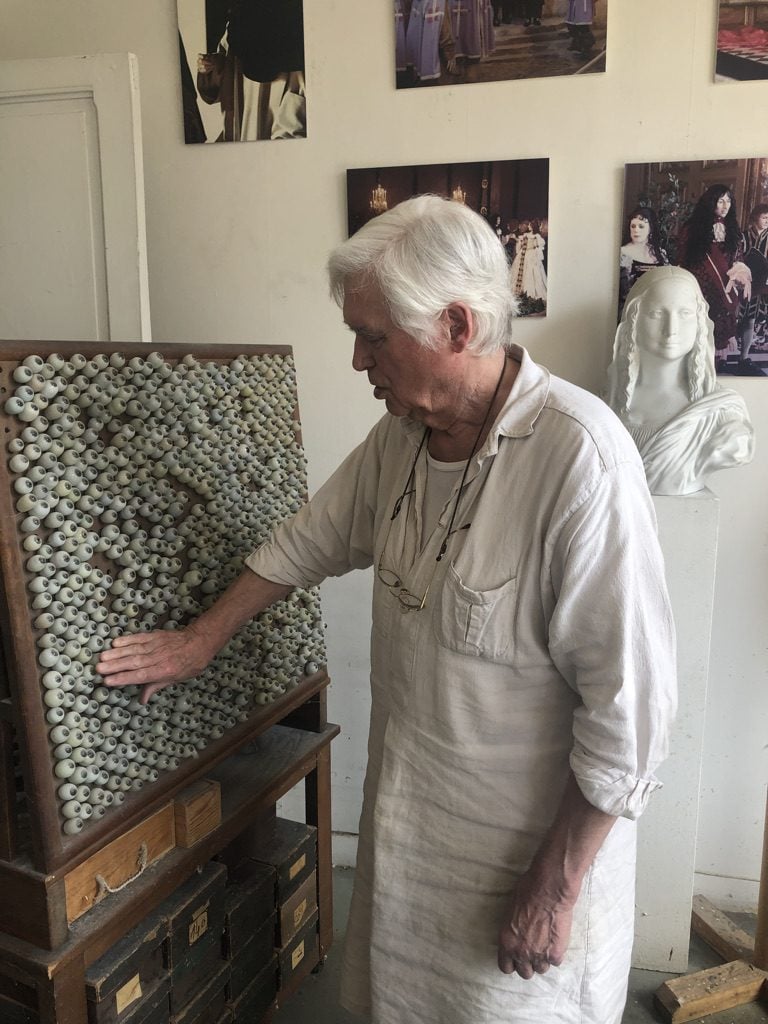
Daniel Druet is suing Cattelan's gallery to claim authorship of nine of the artist's works.

Devorah Lauter

In the studio of French sculptor Daniel Druet, the conceptual artist Maurizio Cattelan is everywhere: In framed magazine covers depicting Cattelan’s sculptures Him (2001), La Nona Ora (1999), and the two upside-down American police officers Frank and Jamie (2002). Then there is the likeness of the Italian provocateur himself—looking cartoon-like in wax busts on wooden poles, his drawn cheeks a little fuller than in real life. The wax Cattelan’s eyes are characteristically wide open, and Druet gave him a rather pleasant smile.
“I never said he wasn’t a nice person. I just don’t have much affinity with him,” Druet said on a recent afternoon at his studio.
Lack of affinity is putting it lightly. We turned a corner, and came upon Druet’s sculpture Coucou, which is “about conceptual art, where other artists have other people do their work for them,” he said. The piece shows Cattelan, who did not commission the work, peeking out of a large egg in a nest, surrounded by smaller eggs, and looking innocently dumb. “He feeds off of the parent birds, or lays his eggs in other nests,” added Druet by explanation, referring to how he feels Cattelan profited off of Druet’s skill as a sculptor.
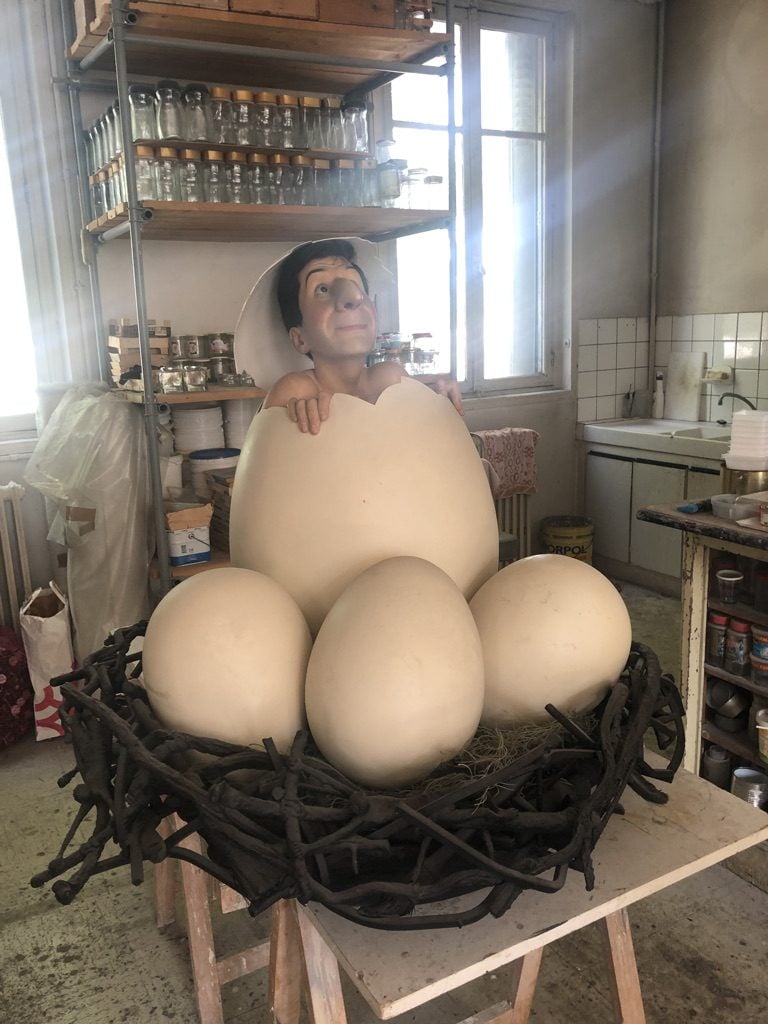
Daniel Druet’s sculpture Coucou, in his studio. Photo by Devorah Lauter.
Druet, an academically trained winner of the Prix de Rome, has accused Cattelan’s longtime gallery, Perrotin, and the museum La Monnaie de Paris, of ignoring his requests to credit him as the sculptor of nine works he made for Cattelan between 1999 and 2006. He is now suing for €4.5 million ($4.69 million) in damages and exclusive authorship of nine wax sculptures.
Perrotin and Cattelan’s lawyers argue that Druet is not only claiming authorship of his wax figures, but entire installations done after Druet delivered them, which in some cases include theatrical scenography. In the case of La Nona Ora, one of the contested works, the pope figure was delivered standing and then Cattelan cut it in half and pinned it with a meteorite-like rock.
Druet and his lawyer told Artnet News that they were only seeking attribution for Druet’s wax artworks, which exist within Cattelan’s larger ones. Druet goes further and questions what artistic role Cattelan had, if any, in some of the wax sculptures on trial, arguing that some were “simply hung on the wall as I had delivered them.”
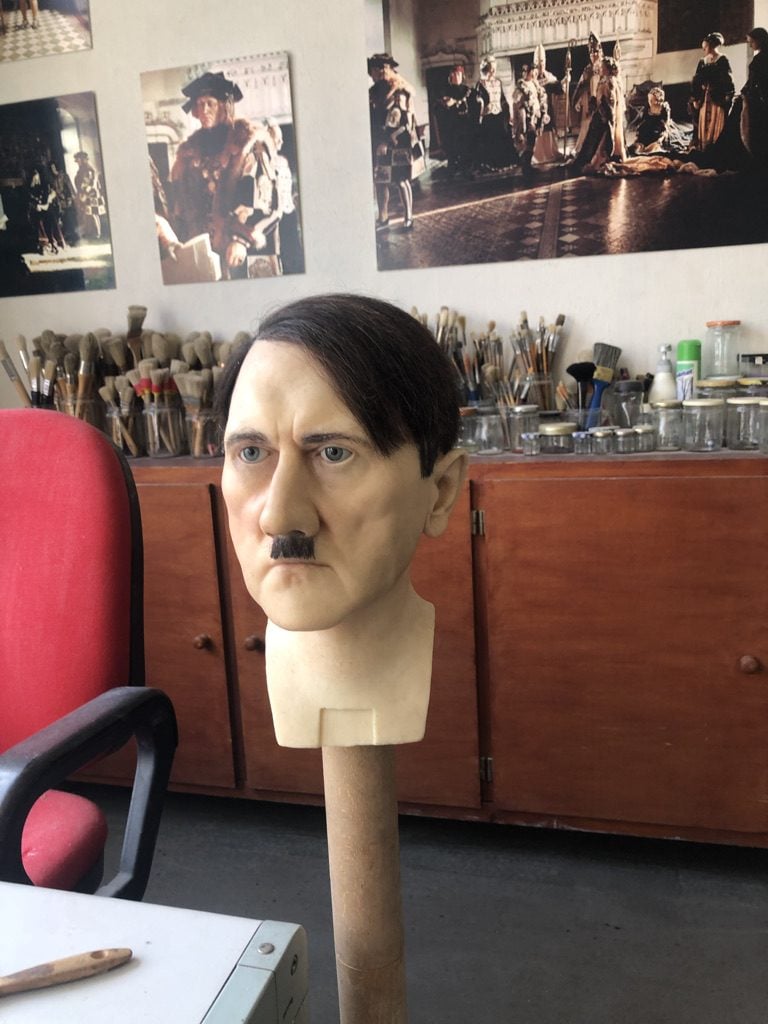
A wax work at Druet’s studio made for Maurizio Cattelan. Photo by Devorah Lauter.
Unnamed assistants have labored to create artworks conceived by others for centuries. Should their contributions receive formal acknowledgement? Or are their skills replaceable and interchangeable, and therefore not worthy of mention?
These are some of the questions French judges are deliberating now in the trial, which began May 13.
The debate is also being widely played out in the press. On May 14, leading figures in France’s art scene signed an editorial in Le Monde backing Cattelan.
“Daniel Druet’s quest for recognition as the exclusive author of the works imagined by Maurizio Cattelan opens the door to the disqualification of conceptual art,” reads the editorial, signed by artists such as Sophie Calle, Annette Messager, and Xavier Veilhan.
Leading up to the trial, Cattelan’s gallerist, Emmanuel Perrotin, told Le Monde, his eyes tearing, according to the reporter, that “Druet will remain in art history. If he loses, the jurisprudence that we’ve waited for so long will finally protect artists against potential abuses of power by manufacturers we don’t even know. If he wins, all artists will be attacked, and it will be the end of contemporary art in France.”
The pieces in question include some of Cattelan’s best known, most controversial, and most valuable creations, including La Nona Ora and Him, depicting Hitler kneeling in prayer, his mustachioed head topping a small body of childlike proportions.
For each work, Cattelan commissioned Druet with a set of instructions. But Druet claims they were so vague that they left him with “total freedom to sculpt as he liked,” according to his lawyer, Jean-Baptiste Bourgeois, during the trial.
Perrotin’s lawyers refuted this claim, noting that detailed instructions were given with “mathematical precision,” and that the finished sculptures were used as part of larger installations.
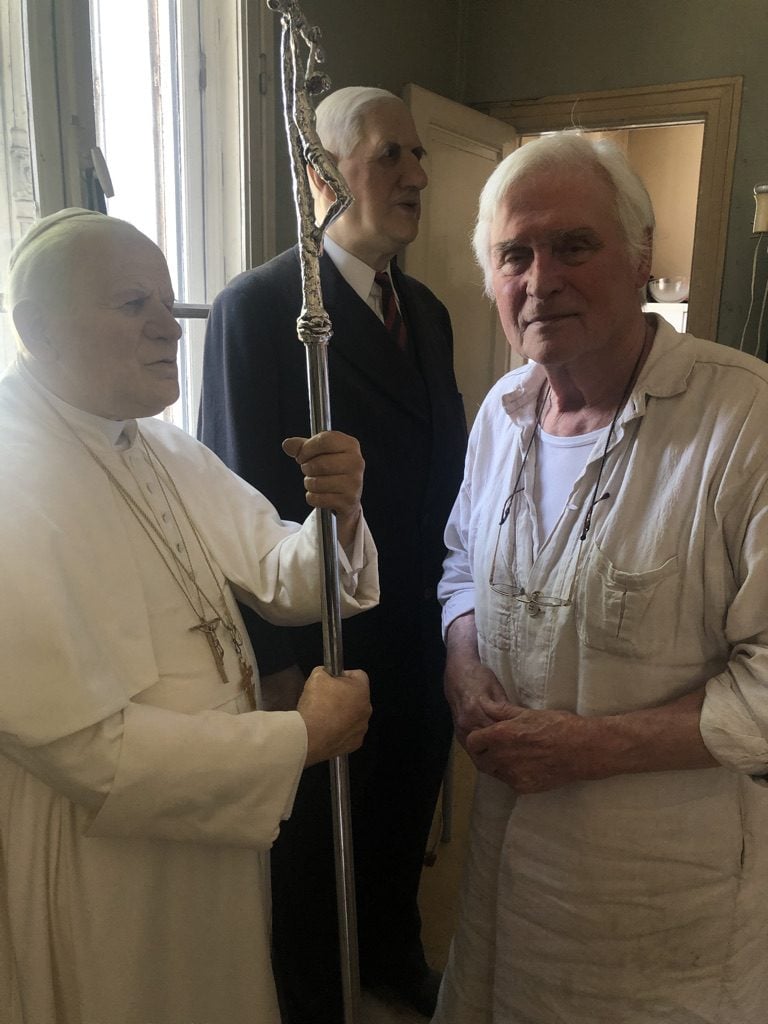
Daniel Druet with a model of the wax sculpture used in La Nona Ora. Photo by Devorah Lauter.
The one-day trial was so crowded with observers and reporters that it had to be moved from the small courtroom reserved for intellectual property cases to a larger space. There, the audience heard arguments on everything from how to define the act of creation, the meaning of conceptual art, to whether Cattelan knows how to draw or paint.
“Does Mr. Cattelan know how to breathe spirit into material?” asked Bourgeois, Druet’s lawyer, referring to a phrase by the Frenchman Raymond Devos. “Never, because he doesn’t know how,” he went on. “There’s a greater distance today, between the person who makes [an artwork] and the person who has the idea.”
“Ideas are not protected by French law,” he concluded.
Cattelan, who was not present at the trial, has never hidden the fact that he doesn’t fabricate many elements of his artworks himself, and instead gives instructions for their execution.
“I never touch the work myself. It’s out of my hands,” Cattelan told then chief curator of the Guggenheim Museum Nancy Spector in a monograph published in 2000. “Of course, I would prefer to have a kind of unmediated representation, but this is not possible, given my process. The meaning of the work is really out of my control.”
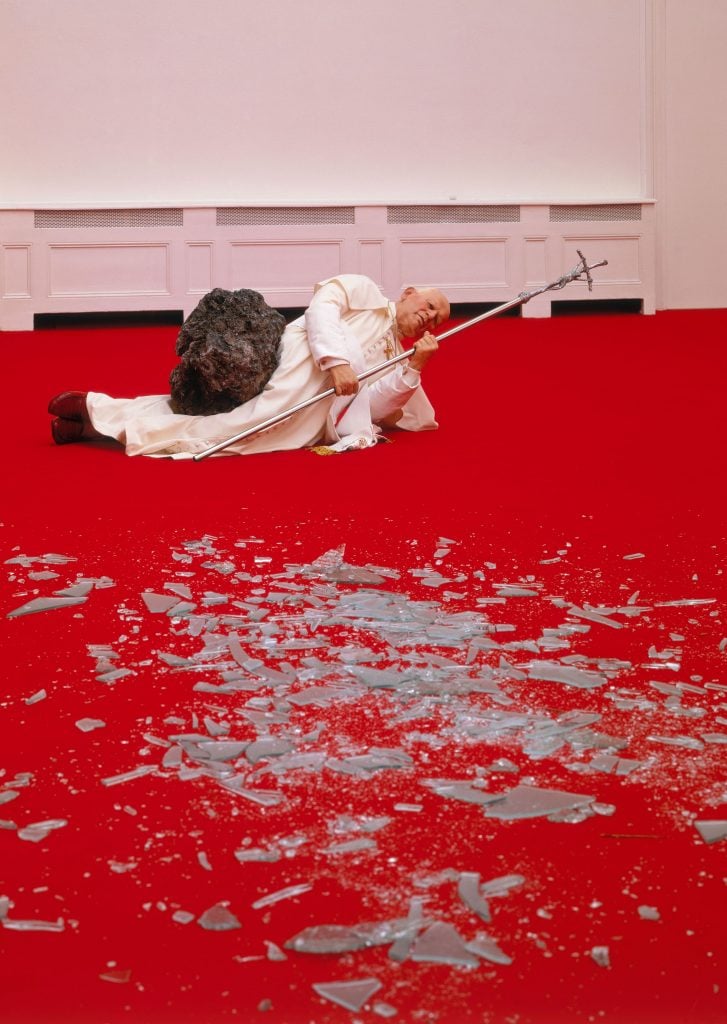
Exhibition view at the Kunsthalle Basel, Basel,
1999. Photographer : Attilio Maranzano. Courtesy of the artist and Perrotin
Cattelan’s team quoted examples of the artist’s instructions to Druet, including, for example, the exact angle at which a pair of eyelids should fall. “Even if [an artist] doesn’t touch a work at all, they can be the exclusive author,” said Perrotin’s lawyer, Pierre-Olivier Sur. To create the works in question, “Druet can be replaced by another sculptor, but Cattelan cannot.”
That claim, however, may be hard to prove in court. French law is “not suitable for conceptual art,” said Sur, who added he hoped this case would help evolve legal precedence.
Druet’s legal argument centered around proving that he is not a “machine,” and he has an artistic “touch,” which captures the expressions of his subjects, often modeled in person. Without it, Cattelan’s work would indeed be different, and possibly not as successful, he argued. Cattelan’s attorneys “are claiming Druet’s creations are the same as [Marcel Duchamp’s] urinal,” said Bourgeois. “That’s jumping the gun.”
(Le Monde has quoted Cattelan’s lawyer Eric Andrieu saying, “Nobody cares who created Marcel Duchamp’s urinal! It’s the same thing for the person who fabricated the little Hitler,” referring to Druet’s wax effigy of Him.)
But would Druet have made those nine sculptures without Cattelan? “They were his ideas, but my way of making them,” Druet said in his studio the day after the trial opened. “It’s the life that I give to each character. I express myself in what I do.”
After Him sold for $17 million at auction in 2016, it’s not hard to imagine why Druet may have felt like he got a raw deal. (Perrotin gallery said it originally sold that piece for €33,333, or $34,753.) The formally trained sculptor was paid an estimated total of about $280,000 for all the works Cattelan commissioned from him, according to Perrotin, and never signed a contract. But Druet, whom Cattelan and Perrotin discovered through a Paris wax museum, claims he took the legal route to “set things right.”
Since his claim, Druet hasn’t been working as much. The editions of wax characters he made for Cattelan years ago—Hitler, the Pope—are always in sight in the studio. Yet the figures are not what he considers his real artistic practice.
“My life is not centered around this. I have my life as a sculptor,” he said, referring to bronze creations that he sculpts at another studio in Paris. “It’s hard to live off of sculpting. What I did for Cattelan was an extension of what I did for the [wax] Grévin Museum. It’s how I made a living.”
His frustration with the Italian artist, as well as Emmanuel Perrotin, became more pointed as we talked. Perrotin “promised me that the gallery would talk about me and bring me a lot of commissions. They never did,” he said, remembering the dealer’s first visit in 1999.
They also never invited Druet to openings. “They wanted to keep me hidden,” he said. “Cattelan was their winning horse. I was just the tool. When they start to forget you exist, it becomes a problem.”
Perrotin’s lawyers said there was never any attempt to hide Druet’s work and pointed to press material about the works and several media reports mentioning him as a result.
In 2016, Druet searched in vain for his name at a Cattelan retrospective at the Monnaie de Paris. The museum and gallery Perrotin declined Druet’s request to have his name appear on every wall label of the works he sculpted, as he formally demanded at the time. (That decision led to the current legal proceedings.)
Would Druet have been content, we asked, to see his name appear as part of a longer, explanatory text at some point in the show?
“Absolutely, that’s simply all I wanted. To be acknowledged as a sculptor,” said Druet.
That may be true, but as of now, Druet’s lawyer affirmed that the sculptor’s name “should be everywhere.”
A verdict in the trial is expected July 8.